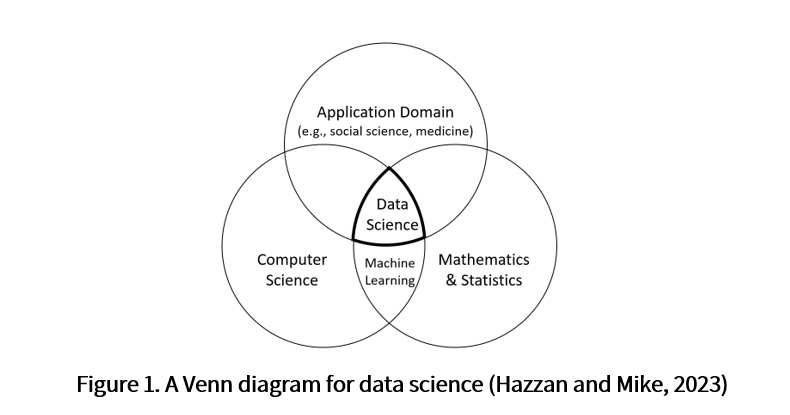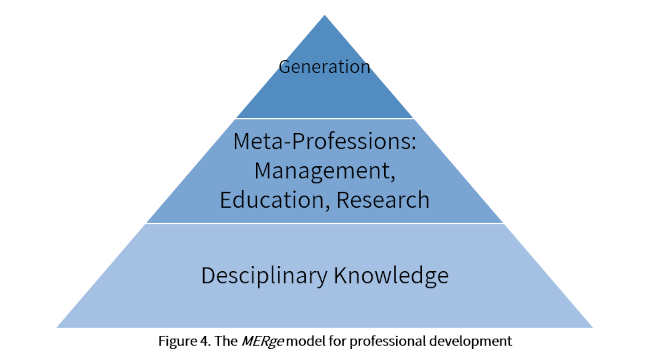Setting
In the 2023 Spring semester, we taught a Data Science for Senior Executives course, that was offered by the Technion’s Department of External Studies and Continuous Education, to 13 senior executives from a variety of Israeli organizations. Eight of the students were employed in the first (government) sector, specifically the tax authority, the State Comptroller and Ombudsman, the Ministry of Energy, and the health system. The other five students came from the second (for-profit) sector, spesifficaly from the areas of semiconductors, advertisement, software, and energy.
Since the executives came from different organizations, the application domain component of data science, for each of them, was the domain of their organization. See Figure 1.
Nevertheless, since all of the executive-students also applied managerial knowledge in their professional work and decision-making processes, the question that should be asked is: Where should management be located in the data science Venn diagram? This is the question we address in this blog.
The executives’ perspectives on management in the context of data science
As a summary class activity, the executives were asked to position management in the data science Venn diagram. They were told they could change the size of the Management circle, making it larger or smaller. Technically, a shared Google slide presentation with 13 slides was prepared. Each slide presented a Venn diagram for data science and a separate circle representing management (see Figure 2). The executives were asked to select a slide, write their name on it, and position the management circle in the given Venn diagram.
Interestingly, the senior executives placed the Management circle and resized it in a variety of ways, that were categorized into four patterns or perspectives (see Figure 3). In what follows, we present these four perspectives by order of centrality and importance attributed to the Management circle. Since we are familiar with the learners’ managerial roles, we can conjecture that this centrality is determined by the position and role of the executives in their organization as well as the profession of their direct employees: data scientists or other professions.
- Management is separate: According to this perspective, management is not part of data science considerations. This placement of management was suggested by an executive who has wide responsibility in her organization in terms of the application domain but does not manage people.
- Management touches each circle: According to this perspective, management is connected to each component of data science separately. This placement was suggested by an executive in a public organization who also fulfills an academic role that includes education and research, in addition to management. When she described her placement of the Management circle in class, she explained that management “touches each component of data science”, which can be interpreted as “management is neither my main concern when I perform my role as an educator or as a researcher, nor do I neglect it”.
- Management is in the background of all: According to this perspective, data science cannot be applied in managerial roles without considering managerial aspects. This placement was suggested by three mid-level managers, who have managerial responsibilities but are not at the top of the managerial pyramid of their organization. When describing their placement of the Management circle, these executives used the terms “behind”, “in the background”, “above”, which indicate that management is always there but yet is not at the core of the data science decision-making processes.
- Management is an additional application domain: This placement regards management as an additional component of data science. It was suggested by four senior executives in high positions, who have wide responsibilities in their organization and who also directly manage several people. This placement implies that management is attributed the same importance as the other components of data science, as reflected by the term “same importance as…” which the executives used when describing their placement of the Management circle in the Venn diagram for data science.
These four perspectives raise interesting questions that will be addressed in our future courses on data science for senior executives, such as: If a manager uses data science to make management decisions in his or her organization, how should he or she balance the application domain considerations and the managerial ones? If the application domain of the organization is given more weight, how is the managerial aspect expressed? and vise versa: if managerial aspects of the decision get more attention, what is the role of the organization’s application domain in the decision-making process?
Examination of the executives’ perspectives on management in the context of data science from the MERge model perspective
The MERge model (developed by Hazzan and Lis Hacohen, 2016) is a professional development framework based on three layers. The lower layer includes the disciplinary knowledge; the second layer includes three meta professions – Management, Education, and Research; and the top layer consists of Generation, which refers to a practitioner’s ability to accomplish professional tasks by integrating the disciplinary knowledge (first layer) with the meta-professions of management, education and research (second layer). See Figure 4.
Management is one of the meta-professions located in the second layer of the MERge model, together with education and research. Thus, one of the questions that should be asked at this point is: Can the above four perspectives of the placement of management in the data science Venn diagram be generalized to education and research?
For example, in the case of education, when a data science educator engages in pedagogical considerations when performing one of his or her professional activities, should the educational perspective be considered for each component of data science separately (as approach B above reflects for management)? Should it be in the background when performing the professional activity (as approach C above reflects with respect to management)? Or should educational considerations be an integral part of the decision-making process that takes place during the performance of the educational activity (as approach D above reflects with respect to Management)? The answer to such questions may have direct influence on a variety of educational decisions, e.g., when designing a data science program, should each component of data science be taught separately? Should they be taught in an intertwined approach, reflecting the interdisciplinarity nature of data science?
The same discussion can be applied to research as a meta-profession, which is included in the second layer of the MERge model. In such as case, questions such as the following should be asked in research processes: If one holds approach B (that is, research touches each component of data science separately), what will be the consequences of research in computer science / statistics that is carried out while considering separately the application domain in the data interpretation?
Summary
The above analysis reflects, once again, not only the importance that should be attributed to the interdisciplinarity of data science, but also the multifaceted nature of the interdisciplinarity of data science and possible consequences of different perspectives on this interdisciplinarity.
References
Hazzan, O. and Lis-Hacohen, R. (2016). The MERge Model for Business Development: The Amalgamation of Management, Education and Research, SpringerBriefs in Business. http://www.springer.com/us/book/9783319302249
Hazzan, O. and Mike, K. (2023). Guide to Teaching Data Science: An Interdisciplinary Approach, Springer. https://link.springer.com/book/10.1007/978-3-031-24758-3#toc.
Orit Hazzan is a professor at the Technion’s Department of Education in Science and Technology. Her research focuses on computer science, software engineering, and data science education. For additional details, see https://orithazzan.net.technion.ac.il/. Koby Mike is a Ph.D. graduate of the Technion’s Department of Education in Science and Technology. He is currently a post-doctoral student at Bar-Ilan University. His research focuses on data science methods for social science and digital humanities research.








Join the Discussion (0)
Become a Member or Sign In to Post a Comment